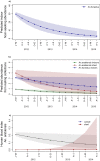Emergence of behavioural avoidance strategies of malaria vectors in areas of high LLIN coverage in Tanzania
- PMID: 32883976
- PMCID: PMC7471940
- DOI: 10.1038/s41598-020-71187-4
Emergence of behavioural avoidance strategies of malaria vectors in areas of high LLIN coverage in Tanzania
Abstract
Despite significant reductions in malaria transmission across Africa since 2000, progress is stalling. This has been attributed to the development of insecticide resistance and behavioural adaptations in malaria vectors. Whilst insecticide resistance has been widely investigated, there is poorer understanding of the emergence, dynamics and impact of mosquito behavioural adaptations. We conducted a longitudinal investigation of malaria vector host choice over 3 years and resting behaviour over 4 years following a mass long-lasting insecticidal nets (LLINs) distribution in Tanzania. By pairing observations of mosquito ecology with environmental monitoring, we quantified longitudinal shifts in host-choice and resting behaviour that are consistent with adaptation to evade LLINs. The density of An. funestus s.l., declined significantly through time. In tandem, An. arabiensis and An. funestus s.l. exhibited an increased rate of outdoor relative to indoor resting; with An. arabiensis reducing the proportion of blood meals taken from humans in favour of cattle. By accounting for environmental variation, this study detected clear evidence of intra-specific shifts in mosquito behaviour that could be obscured in shorter-term or temporally-coarse surveys. This highlights the importance of mosquito behavioural adaptations to vector control, and the value of longer-term behavioural studies.
Conflict of interest statement
The authors declare no competing interests.
Figures


References
-
- World Health Organization . World Malaria Report 2019. Geneva: World Health Organization; 2019.

